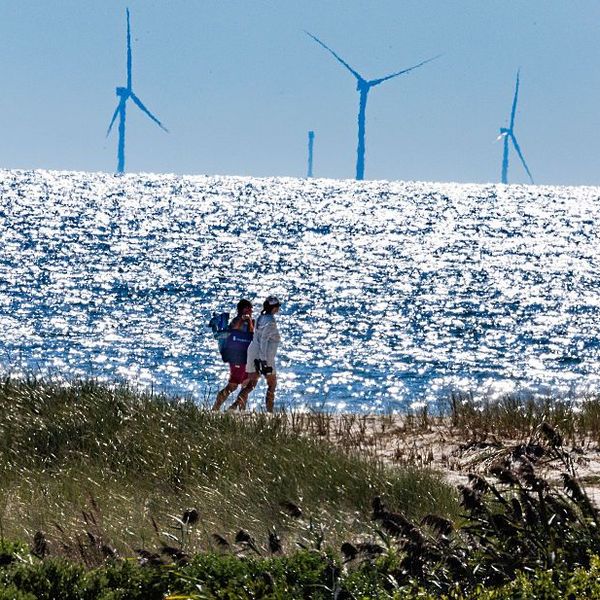
"In the industrialized world, Denmark will be the vanguard of renewable energy by 2022, with 70 percent of its electricity generated by wind, solar and other renewables," Cole writes. (Photo: Oregon Department of Transportation/Flickr/cc)
Top Ten Renewable Energy Surprises in New IEA Report
A new International Energy Agency report contains some startling findings about solar energy dominance and its future.
A new International Energy Agency report contains some startling findings about solar energy dominance and its future.
1. Renewables comprised 66% of all new net electricity capacity additions in 2016. Two-thirds of added capacity, in other words, consisted of photovoltaic solar cells, wind turbines and biofuels.
2. 165 gigawatts of new solar was added in 2016.
3. In 2016, new solar photovoltaic capacity globally grew by 50 percent.
4. China accounted for half of this additional solar capacity and for 42% of all new renewables additions.
5. Solar additions grew faster than any other fuel, leaving coal in the dust.
6. By 2022, the IEA expects nearly 1000 gigawatts of new solar to have been added internationally, an increase of 42 percent over today, in just 5 years.
7. Developments in India are also startling. By 2022 that country is expected to double its renewables electricity generation capacity (mainly wind and solar), a lightning fast pace of growth that is higher than the forecast for Europe.
8. Indian energy auctions yielded remarkably low prices for both wind and solar projects. In some Indian states, recent bids have been among the world's lowest, and in some cases so low as to complete successfully with coal.
9. In the industrialized world, Denmark will be the vanguard of renewable energy by 2022, with 70% of its electricity generated by wind, solar and other renewables.
10. In several major European states, the share of wind and solar in electricity generation will come to 25%.
An Urgent Message From Our Co-Founder
Dear Common Dreams reader, The U.S. is on a fast track to authoritarianism like nothing I've ever seen. Meanwhile, corporate news outlets are utterly capitulating to Trump, twisting their coverage to avoid drawing his ire while lining up to stuff cash in his pockets. That's why I believe that Common Dreams is doing the best and most consequential reporting that we've ever done. Our small but mighty team is a progressive reporting powerhouse, covering the news every day that the corporate media never will. Our mission has always been simple: To inform. To inspire. And to ignite change for the common good. Now here's the key piece that I want all our readers to understand: None of this would be possible without your financial support. That's not just some fundraising cliche. It's the absolute and literal truth. We don't accept corporate advertising and never will. We don't have a paywall because we don't think people should be blocked from critical news based on their ability to pay. Everything we do is funded by the donations of readers like you. Will you donate now to help power the nonprofit, independent reporting of Common Dreams? Thank you for being a vital member of our community. Together, we can keep independent journalism alive when it’s needed most. - Craig Brown, Co-founder |
A new International Energy Agency report contains some startling findings about solar energy dominance and its future.
1. Renewables comprised 66% of all new net electricity capacity additions in 2016. Two-thirds of added capacity, in other words, consisted of photovoltaic solar cells, wind turbines and biofuels.
2. 165 gigawatts of new solar was added in 2016.
3. In 2016, new solar photovoltaic capacity globally grew by 50 percent.
4. China accounted for half of this additional solar capacity and for 42% of all new renewables additions.
5. Solar additions grew faster than any other fuel, leaving coal in the dust.
6. By 2022, the IEA expects nearly 1000 gigawatts of new solar to have been added internationally, an increase of 42 percent over today, in just 5 years.
7. Developments in India are also startling. By 2022 that country is expected to double its renewables electricity generation capacity (mainly wind and solar), a lightning fast pace of growth that is higher than the forecast for Europe.
8. Indian energy auctions yielded remarkably low prices for both wind and solar projects. In some Indian states, recent bids have been among the world's lowest, and in some cases so low as to complete successfully with coal.
9. In the industrialized world, Denmark will be the vanguard of renewable energy by 2022, with 70% of its electricity generated by wind, solar and other renewables.
10. In several major European states, the share of wind and solar in electricity generation will come to 25%.
A new International Energy Agency report contains some startling findings about solar energy dominance and its future.
1. Renewables comprised 66% of all new net electricity capacity additions in 2016. Two-thirds of added capacity, in other words, consisted of photovoltaic solar cells, wind turbines and biofuels.
2. 165 gigawatts of new solar was added in 2016.
3. In 2016, new solar photovoltaic capacity globally grew by 50 percent.
4. China accounted for half of this additional solar capacity and for 42% of all new renewables additions.
5. Solar additions grew faster than any other fuel, leaving coal in the dust.
6. By 2022, the IEA expects nearly 1000 gigawatts of new solar to have been added internationally, an increase of 42 percent over today, in just 5 years.
7. Developments in India are also startling. By 2022 that country is expected to double its renewables electricity generation capacity (mainly wind and solar), a lightning fast pace of growth that is higher than the forecast for Europe.
8. Indian energy auctions yielded remarkably low prices for both wind and solar projects. In some Indian states, recent bids have been among the world's lowest, and in some cases so low as to complete successfully with coal.
9. In the industrialized world, Denmark will be the vanguard of renewable energy by 2022, with 70% of its electricity generated by wind, solar and other renewables.
10. In several major European states, the share of wind and solar in electricity generation will come to 25%.

